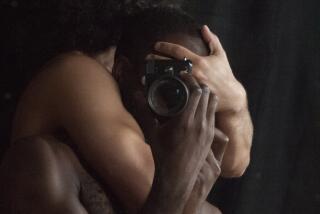- Share via
He saw history unfolding in front of him: The massacre at Tiananmen Square. The chaotic coup attempt to unseat Gorbachev. The swift stroke of the pen that marked the fall of the USSR. And, yes, Shanghai’s first American fashion show (Bianca Jagger modeling Halston!). Time and again, Pulitzer Prize-winning photojournalist Liu Heung Shing positioned himself at political and cultural turning points, capturing, from a mere lens-length away, the telltale moments in China’s rise and the Soviet Union’s demise.
Liu’s impressive new photo book, “A Life in a Sea of Red,” is a rat-a-tat-tat I-was-there collection of the most memorable, most revealing pictures made during a 40-year career covering China and Russia at times of unprecedented upheaval. Outside of journalism circles, Liu’s isn’t exactly a household name, but he’s been called the Cartier-Bresson of China — and the sweeping black-and-white and color pictures in this 288-page, substantially sized book make an extremely compelling case.
Born in Hong Kong and schooled in mainland China, Liu moved to New York to attend college. There, he took a class with legendary Life magazine photographer Gjon Mili, who later asked him to intern at Life. In 1976, Time magazine sent Liu, then just 26, to China to cover Mao Zedong’s funeral — and so began the career of the ultimate inside-outsider, the rare photographer able to see events play out from both the Chinese and the Western perspective.
As a photojournalist, Liu is blessed with many gifts, among them an uncanny ability to spot the small moments of ordinary life that come to stand for something larger, as well as a newshound’s nose for being at the right place at the right time. “Sea of Red” is full of examples: the workers quietly removing a large poster of Mao, the blurred-on-purpose moment Gorbachev signed the document that closed the book on the Soviet Union, a happy patient standing with the only plastic surgeon in 1980 Beijing performing Western “eye job” surgeries. But perhaps the most astonishing picture is Liu’s cinematic shot of a young couple on a bicycle hiding under a bridge during the Tiananmen protests as tanks rumble on the street just above them.
The book features 195 images, many of them masterworks of composition on the fly. “The selection process,” Liu told The Times via email, “was from thousands rather than tens of thousands [of photos] because I worked in film, not digital. I was taught to make every frame count.” But aside from the pictures themselves, the captions provide a bonus layer of entertaining detail: Those winter cabbages the peasants gracefully toss into a truck? Liu writes that they weigh at least 22 pounds apiece. That plastic surgeon? He worked on one eye at a time so the patient would be able to bicycle home.
The publication of “Life in a Sea of Red,” by distinguished photo-book publisher Steidl, comes at an interesting time, with Russian political machinations once again taking the world stage. But it’s also the perfect moment to look back on China’s ascendancy, as this year marks the 30th anniversary of the Tiananmen protests, the 40th anniversary of China’s economic reform, and the 70th anniversary of the founding of the People’s Republic of China. Liu has been along for much of that ride. He told me that, even as a young man in 1976, he sensed that “the story of the potential transformation of the People’s Republic — as it involved a fifth of the world’s population — would be an earth-shaking story, so I just kept at it.” And keep at it he did.
::
“Life in a Sea of Red: The Photography of Liu Heung Shing”
Pi Li, Geoff Raby and Christopher Phillips
Steidl: 288 pp., $95
Shapiro is the former editor in chief of Life magazine and the author of “What We Keep.”
More to Read
Sign up for our Book Club newsletter
Get the latest news, events and more from the Los Angeles Times Book Club, and help us get L.A. reading and talking.
You may occasionally receive promotional content from the Los Angeles Times.






